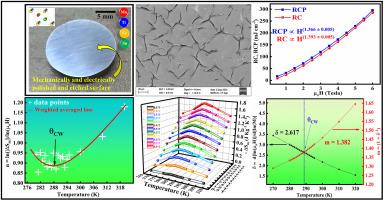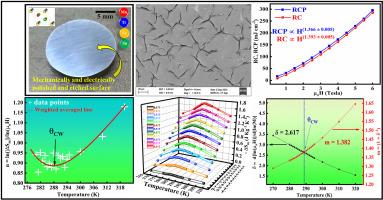Harnessing room-temperature magnetocaloric effect in hexagonal full-Heusler-like alloy Mn2(Ti0.2Fe0.8)Sn: Paving the way for next-generation applications
IF 9.7
2区 材料科学
Q1 MATERIALS SCIENCE, MULTIDISCIPLINARY
引用次数: 0
Abstract
Room temperature (RT) large cooling power per unit volume, high working temperature span, and moderate magnetocaloric response (MCR) across Curie temperature is achieved in high-quality polycrystalline half-metallic Full Heusler Like Alloy (FHLA): Mn2(Ti0.2Fe0.8)Sn. At RT, this FHLA exhibits an exceptional Mg3Cd (or Ni3Sn) type hexagonal structure (Space group P63/mmc, no. 194, Strukturbericht designation-D019) instead of cubic, as confirmed by Raman and X ray diffraction study. A unique, exotic microstructural feature, which is rarely observed in the case of Full Heusler Alloy (FHA), is revealed. DSC (Differential Scanning Calorimetry) and magnetic measurements confirm the Curie temperature to be near the room temperature. The calculated value of the RWR (Rhodes-Wohlfarth Ratio) = 2.759 (>1), signifies that the system exhibits characteristics of an itinerant ferromagnet. For 6 T (Tesla) magnetic field change, across its Curie temperature, this FHLA delivers a working temperature span (ΔTFWHM) as high as ∼ 20 K, a significant refrigerant capacity (RC) of 285.51 mJ cm−3 and; relative cooling power (RCP) of 295.70 mJ cm−3, indicating its potency to be utilized in miniaturized engineering design in technology for its low constituent cost, low coercivity, an easy sample synthesis technique, and ability to exhibit substantial cooling power in a minimal volume. Furthermore, this refrigerant could serve as a viable substance for regulating the liquefaction and solidification processes of these harmful VOCs (Common volatile organic compounds) near room temperature. This finding, undoubtedly, enlightens understanding of complex magnetic behaviour and significant MCR effects in FHA, having an unusual exceptional structure, a unique microstructural morphology, and a Curie temperature in the proximity of RT.


利用六方全类赫斯勒合金Mn2(Ti0.2Fe0.8)Sn的室温磁热效应:为下一代应用铺平道路
高质量多晶半金属Full Heusler Like Alloy (FHLA): Mn2(Ti0.2Fe0.8)Sn在室温(RT)下具有大的单位体积冷却功率、高的工作温度范围和中等的居里温度磁热响应(MCR)。在RT下,该FHLA表现出特殊的Mg3Cd(或Ni3Sn)型六方结构(Space group P63/mmc, no. 5)。1994, Strukturbericht编号- d019),而不是立方,经拉曼和X射线衍射研究证实。揭示了一种在全赫斯勒合金(FHA)中很少观察到的独特的、奇异的显微组织特征。DSC(差示扫描量热法)和磁测量证实居里温度接近室温。RWR (Rhodes-Wohlfarth Ratio)的计算值为2.759 (>1),表明该体系具有流动铁磁体的特性。对于6 T(特斯拉)的磁场变化,在其居里温度范围内,该FHLA提供高达~ 20 K的工作温度范围(ΔTFWHM),显著的制冷剂容量(RC)为285.51 mJ。cm-3;相对冷却功率(RCP)为295.70 mJ。Cm-3,表明其在小型化工程设计技术上的潜力,因为它的低组成成本,低矫顽力,简单的样品合成技术,以及在最小体积内表现出可观的冷却能力。此外,该制冷剂可以作为一种可行的物质,用于调节这些有害VOCs(常见挥发性有机化合物)在室温附近的液化和凝固过程。毫无疑问,这一发现启发了人们对FHA中复杂的磁性行为和显著的MCR效应的理解,FHA具有不寻常的特殊结构、独特的微观结构形态和接近RT的居里温度。
本文章由计算机程序翻译,如有差异,请以英文原文为准。
求助全文
约1分钟内获得全文
求助全文
来源期刊

Materials Today Physics
Materials Science-General Materials Science
CiteScore
14.00
自引率
7.80%
发文量
284
审稿时长
15 days
期刊介绍:
Materials Today Physics is a multi-disciplinary journal focused on the physics of materials, encompassing both the physical properties and materials synthesis. Operating at the interface of physics and materials science, this journal covers one of the largest and most dynamic fields within physical science. The forefront research in materials physics is driving advancements in new materials, uncovering new physics, and fostering novel applications at an unprecedented pace.
 求助内容:
求助内容: 应助结果提醒方式:
应助结果提醒方式:


